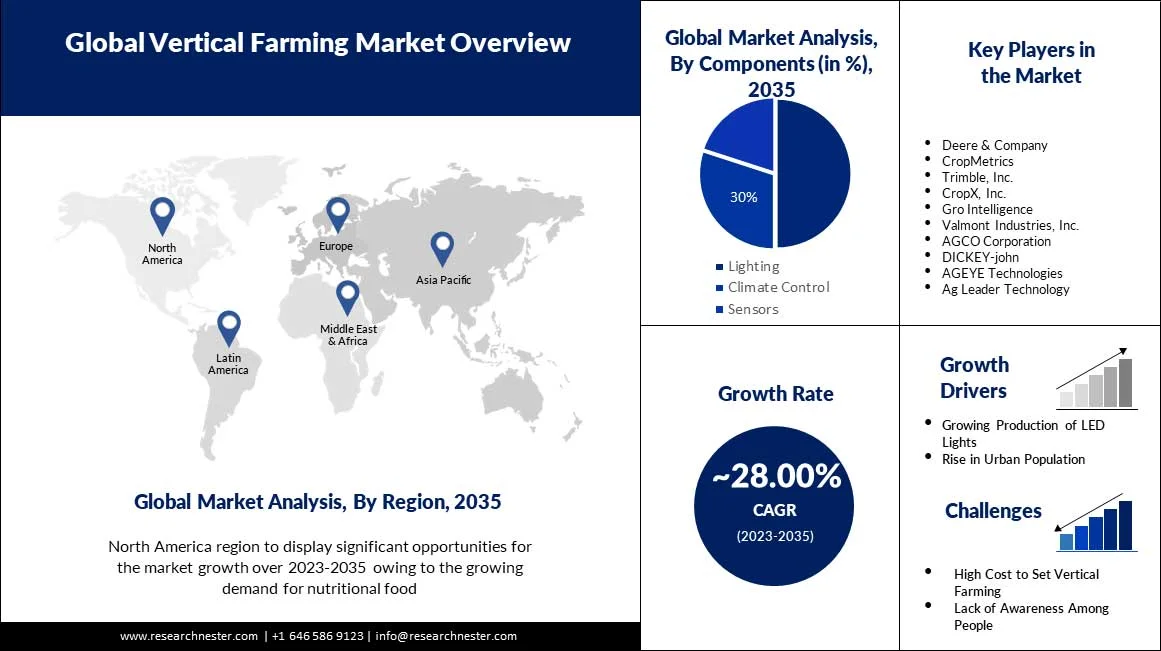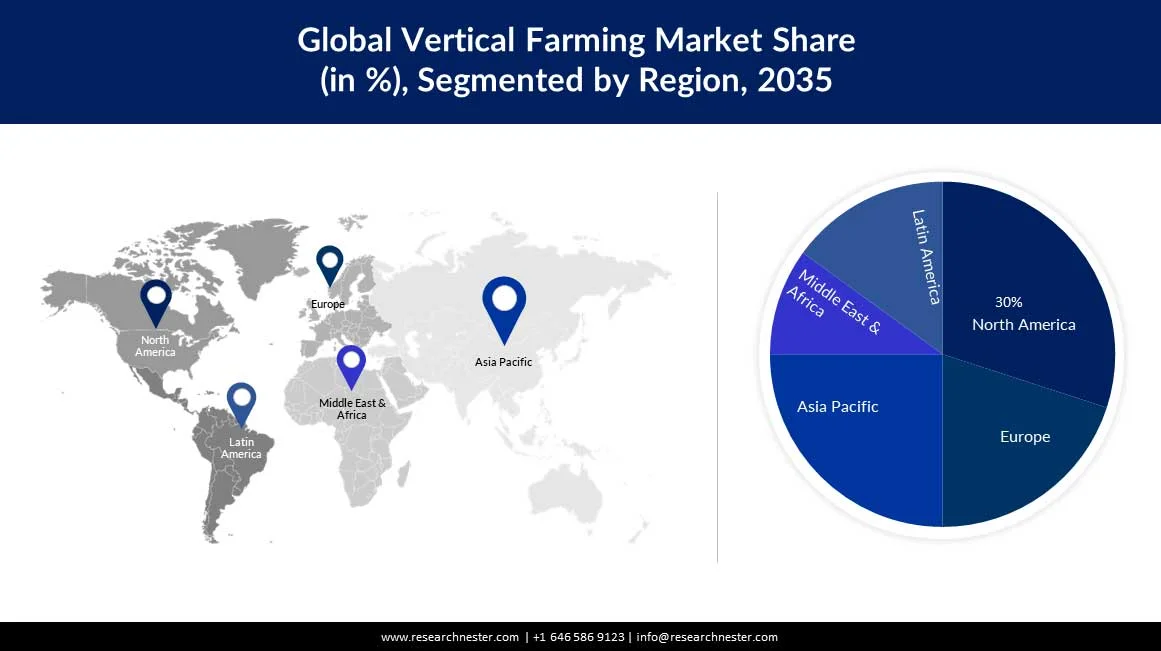
Vertical Farming Market size is projected to surpass USD 96.33 billion by the end of 2035, growing at a CAGR of 28% during the forecast period, i.e., 2023-2035. In the year 2022, the industry size of vertical farming was over USD 4.98 billion. The growth of the market can be attributed to growing demand for organic food owing to improved standard of living of the people and their concern towards health. For reasons related to their health, about 75% of adult bought organic food in 2022, in US. Hence, the demand for organic farming is estimated to increase. Producing crops of the highest quality while having the least negative influence on the environment is the goal of organic farming. In this, it is completely forbidden to use any dangerous synthetic chemicals, including pesticides, herbicides, fungicides, and other contaminants of the soil and water. On the other side, vertical farming represents a more contemporary approach to the established organic agricultural system.
Moreover, there has been growing scarcity of agriculture land which is why the demand for vertical farming is growing. Farmers may utilize about 98 percent less land and approximately 97 percent less water by using vertical agricultural techniques. Through constant or rolling harvesting throughout the year, they could produce agricultural yields that are about 239 times greater than those of conventional farms. Moreover, vertical farming delivers enhanced annual productivity and reliable year-round production. Just some seasonal fruits and vegetables were offered by convectional farming. Instead, with little reliance on weather or environment, vertical farms may grow a wide variety of crops all year round.

Growth Drivers
Challenges
|
Base Year |
2022 |
|
Forecast Year |
2023-2035 |
|
CAGR |
28.00% |
|
Base Year Market Size (2022) |
USD 4.98 Billion |
|
Forecast Year Market Size (2035) |
USD 96.33 Billion |
|
Regional Scope |
|
Components (Lighting, Climate Control, Sensors)
The global vertical farming market is segmented and analyzed for demand and supply by components into lighting, climate control, and sensors. Out of which, the lighting segment is anticipated to garner the highest revenue by the end of 2035. The growth of the segment can be attributed to growing use of LED lights. The extraordinary advancements in light-emitting diode (LED) technology over the past few years have been a major factor in the phenomenal expansion of vertical farming. For many years, only the most lucrative crops were grown in artificial light-dependent indoor growing facilities since they were so expensive to run. However, LEDs are now so reasonably priced and effective that they are fundamentally altering the economics of indoor farming. For the following three decades from 2020 to 2050, it is anticipated that LED light prices would continue to decrease in the United States. In 2017, the price of a kilolumen was about USD 0.6. In 2050, it's predicted to fall to about 0.2 USD. Even more encouraging are the projected prices for LED fixtures and lamps that provide warm and cold light. By 2035, it is projected to fall to approximately 0.2 US dollars per kilolumen.
Structure (Building-Based Vertical Farms, Shipping Container-Based Vertical Farms)
The global vertical farming market is also segmented and analyzed for demand and supply by structure into building-based vertical farms, and shipping container-based vertical farms. Amongst which, the shipping container-based segment is anticipated to have the significant growth over the forecast period. This growth is attributed to the structure's ability to support crop production regardless of location. One of the main benefits of container farming is that it could be moved easily and doesn't need a large plot of land or a special facility to start growing. Also, as competition expands, shipping container prices decrease since it is very inexpensive to acquire used containers, allowing more businesses to enter the market. However, such systems have some drawbacks, such as low comparative productivity and antagonism between light, heat, and layout. Hence, there are various technological improvement carried out which is estimated to boost the demand for shipping container-based vertical farms.
Our in-depth analysis of the global vertical farming market includes the following segments:
|
By Growth Mechanism |
|
|
By Structure |
|
|
By Components |
|
|
By Crop |
|
North American Market Forecast
The market share of vertical farming in North America, amongst the market in all the other regions, is projected to have the highest growth by the end of 2035, backed by growing demand for nutritional food, along with surge in investment in facilitating ecosystem for future food. The availability of freshly harvested veggies across retail outlets is anticipated to rise across the nation as consumer preferences shift towards "fresh-from-farm-to-table" products (which is also the pioneer in adopting this concept). Moreover, there has been population in this region which is demanding more food. However, with the growing demand for food, the scarcity of agriculture land is also growing which would further boost the demand for vertical farming in this region. Farmland is lost on average about 1,999 acres every day in US. The US lost approximately 2 million acres of agriculture in the year 2021 alone.
APAC Market Statistics
The Asia Pacific vertical farming market is estimated to be the second largest, to have the highest growth. In metropolitan areas of Asia Pacific, a new urban environment has recently arisen. Many megacities started initiatives to support the new ecosystem services, including transporting clean, fresh vegetables and offering the most efficient and sustainable food supply options in this region. One of the most important areas of concentration is energy sustainability research, which includes optimizing energy efficiency to satisfy the needs of citizens and businesses. One of agriculture's most remarkable innovations, indoor urban vertical farming (IUVF), is totally dedicated to supplying urban dwellers' food demands at the lowest possible environmental and energy costs in Asia Pacific region. Moreover, with the new features and technologies, vendors may draw in new clients and increase their presence in developing countries, propelling the Asia Pacific vertical farming market.
Europe Market Forecast
Additionally, the vertical farming market in Europe region is also estimated to have significant growth over the forecast period. Increasing use of automation and digitization in vertical farming would probably fuel market expansion in this region during the anticipated term. In vertical farming, automation and digitization decrease time, lower distribution and environmental costs, boost output, and standardize high quality. Moreover, agriculture is now driven by vertical farming, which has made the Internet of Things (IoT) into a mainstream technology in Europe region. The development of IoT has transformed the agricultural industry and accelerated market expansion in this region. Moreover, the vertical farming market has been expanding in many ways throughout Europe as a result of rising populations and per capita incomes, which have shifted customer tastes for healthier, organic, and environmentally friendly meals. Vertical farming market now have a number of new prospects owing to this in this region.



Since their strategic partnership was announced on February 15th, 2023, HYVE Indoor Farming Systems, a solutions-based manufacturer of Controlled Environment Agriculture (CEA) systems, and AGEYE technologies, a pioneer in automated platform monitoring for vertical farms and greenhouses, have announced their first joint indoor vertical farming project. An indoor farm in Nebraska is the initiative, and it would start right away. The project's size would be about 12,000 square foot grow facility with a primary concentration on leafy greens.
A Valmont Industries, Inc. company, Valley Irrigation, announced its joint venture with private holding company Kusto Group and advanced its engagement with the Republic of Kazakhstan. The comprehensive, multi-year project would lay the groundwork for making the nation an agricultural hub in Central Asia by enhancing sustainability and resource conservation, introducing cutting-edge farm technologies to regional farmers, and improving sustainability and resource conservation.
Author Credits: Shivam Bhutani, Anil Kumar
FREE Sample Copy includes market overview, growth trends, statistical charts & tables, forecast estimates, and much more.
Have questions before ordering this report?